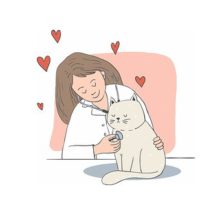Your cantankerous cat lady would like you to remember: A cat is not a dog. Cats are very adaptable, as long as their simple needs  are met. In this post, I will cover some basic cat’s health information and how you can meet these needs.
are met. In this post, I will cover some basic cat’s health information and how you can meet these needs.
HOW DO YOU INTRODUCE YOUR NEW CAT TO A CAT ALREADY IN RESIDENCE?
Cats are territorial animals. If they are introduced into a household that already has a cat or two, have patience. Allow them a period of adjustment. You might keep them in separate rooms at first. They will hear and smell each other, and, of course, will be curious. After a couple of days, or even weeks, they should gradually get used to each other.
I had an experience once when I lived in a 5th wheel trailer with my Siamese cat, Maxine. I left her alone all day, and thought she might be lonesome. So, I found a darling kitten at the Animal Shelter in Kodiak, AK, where I lived, and brought it home. Believe me,

a 5th wheel trailer is not a good place to introduce cats to each other. I had to keep the kitten in the carrier at all times when I was not present, because Maxine wanted nothing to do with the poor thing. I was afraid she would attack it or even kill it. Even with the kitten in the carrier, Maxine growled ALL NIGHT and I got no sleep. I finally had to return the kitten.
Put the cats in separate rooms, and after a day or two, switch them to the room the other occupied, so they get used to each other’s smell. You might put the new cat in a carrier for the first few meetings, so they can sniff each other through the carrier door. Once they are calm, and seem unconcerned about each other, you can try opening the doors to the rooms they occupy and allow them to actually meet.
A friend came to stay with me for a couple of months, and brought her wonderful cat, Raja, with her. We set the carrier down on the living room floor, and my cat, Carlos, came up to check it out. Raja, normally a very calm cat, came unglued! It was a good thing he was in that carrier, or all hell would have broken loose.
My friend and Raja stayed in a bedroom at the end of the trailer, and with the door closed, all was fine. They could smell each other from a safe distance. One day, we went off somewhere together. I said, “Just leave Raja in your bedroom and close your door. I’m sure they will be fine.”
We came home to find Carlos nowhere in sight. “Uh-oh,” I said. “I forgot that Carlos can open that bedroom door.” We went down the hallway, and found the bedroom door standing open. All was silent. We walked down the hallway and looked in the door. Both cats were there, sitting a few feet apart, staring at each other. I am sure they were having a silent conversation. After that, they became good friends, and went on hunting trips together. They had had enough time to get used to each other, and Carlos, being quite mellow and congenial, gave Raja permission to be in his territory.
YOUR VET IS YOUR BEST RESOURCE

Make sure you find a vet you trust, and take your cat in for an initial check-up. Ask the vet’s advice as to what your cat needs to stay healthy.
Diet is important. Sometimes a cat has a physical problem that necessitates a certain kind of food. Be sure to follow your vet’s advice on feeding to insure the cat has a long and healthy life. A meat-based protein diet is good. The food should have the additives that are specific to a cat’s dietary needs. Canned tuna might be okay for a very occasional treat, but does not have specific cat nutrients. Raw meat is not a good choice, as the meat may contain parasites that can cause disease in your cat.
My cat, Carlos, developed FUS (feline urinary syndrome), which is often a problem that develops in male neutered cats. Fortunately, I knew the symptoms, as I’d had another cat with the same problem. The cat’s urinary tract swells until it can close completely. I’d noticed Carlos doing extra scratching in his box, and taking a long time to actually pee. Then, one day he came from his “bathroom” in to the kitchen where I sat, jumped up next to me, and gave two yowls of pain. I knew right away what the problem was. I put him in his carrier and rushed to the vet. There, she had to manually press the urine out of his body, causing him to give a cry of pain. Bloody urine came out. She said I’d brought him in soon enough that there was no infection. She gave him a shot, gave me pills to feed him in those helpful “pill pockets,” and the FUS never came back.

He was put on a specific wet food. The vet did not have the dry food made specifically for that condition. For six weeks he got only wet food. He rebelled, because he wanted his dry food back (I usually fed him some of each every night.) He’d eat a few bites of the meal, then scrape the floor — a way of saying, “This food is awful! I want my dry food back.” After a few hours, he’d get hungry enough to come back and eat what I’d given him. This behavior continued for a few weeks until the vet finally got in the proper kind of dry food. Carlos was a very happy cat to have some dry munchies back in his meal.
CAT HEALTH CARE INFORMATION ON HOW TO PREVENT DISEASE
Your vet will recommend the appropriate vaccinations. All kittens and cats need certain vaccines. These include:
- A core vaccination which protects against feline herpes virus, feline calcivirus, and feline panleukopenia
- A rabies vaccine
- FeLV and FIV vaccines, if your vet recommends these.
Before you visit your vet, make a list of the questions you have about your cat’s health. There are five “silent” killers of cats. These include chronic kidney disease, hyperthyroidism, diabetes mellitus, cardiac disease, and cancer. I’d suggest you get a good book on cat health, which gives the symptoms of these diseases so you will know what to look for. I have a well-worn copy of “The Book of the Cat,” by Michael Wright and Sally Waters. This book has served me well. You can do a little online research to learn what is available, or, again, ask your vet for a recommendation.
MISCELLANEOUS CAT HEALTH CARE INFORMATION

Don’t succumb to your cat’s pathetic requests for more food when you know he’s had enough. An obese cat is a cat that may suffer serious problems later in life. Ask your vet to explain the proper amount the cat should receive at each meal.
Keep his litter box clean. Clean it every day. If you have multiple cats, you may need to clean that box twice a day. The cat prefers a clean box, and you will be able to monitor his use of his “bathroom.” For example, you can notice frequent urination, which may be an indication of a health problem. You will be able to pick up on medical problems sooner.
When I met Carlos Cat, he lived in the animal shelter. On my second visit, I found him in a side room, sitting on a table next to a cat box that an attendant was cleaning. He watched every move to make sure she did the box properly. He was a fastidious animal, and appreciated cleanlines
Also, if you keep that box clean, you won’t have that unpleasant cat urine smell in your house. If you use a non-clumping litter, change the litter often and wash out the box. If you use clumping litter, take out the urine clumps with the feces.
HOW CAN YOU TELL IF YOUR CAT IS IN PAIN?
This one is not always easy, as cats seem to be quite stoic, preferring to suffer in silence. However, there are clues to watch for. Here are the top five signs:
- Decrease in appetite
- Avoidance of bright spots
- Growling
- Groaning
- Eyes closed
These five are indications of intense pain. There are others on the list. If you think you cat is in pain, call your vet.
Mild pain is harder to assess, but if you see changes in your cat’s normal behavior, there may be a problem. There were times when I wondered about my last cat, Carlos, as he didn’t seem quite his usual self. However, he did not give me any positive indication that he was in pain. Only twice did he tell me vocally that he was in pain, each time by giving two anguished yowls. Those signals were unmistakable..
LOVE YOUR CAT TO RECEIVE LOVE IN RETURN

Be sure to give your cat lots of affection and attention. Never hit a cat. If he is seriously misbehaving, a swat with a rolled-up newspaper may be sufficient to straighten him out. Or, try clapping your hands together sharply. Cats do not like loud noises. A loud clap may be a good way to get his attention.
Cats like routine. They do not react well to change. However, if you want your cat to be more cosmopolitan, try taking him with you now and then, perhaps to a friend’s house, so he has new areas to explore. Such an outing gets him a bit more used to new people and places.
DO YOUR CAT HEALTH INFORMATION RESEARCH
There are great online articles you can read that will give you more information than the outline I have presented here. One such site is the Pet Health Network. It is most important that you enjoy your new family member. As you get to know each other, the bond between you can become strong and extremely rewarding to both of you.


Very interesting and kind of cool. I like all animals and cats are cute.
Thanks, Tim. I appreciate your comments. I like the idea of connecting with other folks who like animals.
Cats are always so unpredictable and you really seem to address that! These are some excellent tips that apply to all cats
Thanks, Sydney! I do appreciate your comment. There is so much more to the subject. Perhaps I’ll do another “cat health” post later.
Well written and concise, so as to soothe anyone’s concerns over our cats health, as sometimes one can get overwhelmed sorting through all the available information out there.
Thank you for your comment, Aimee. It’s an overview about a broad topic. I am glad you found it helpful.